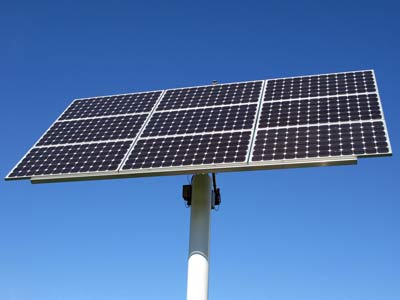|
Solar Panels
Solar Panels - seems like a relatively simple topic Doesn't it? Sun hits a panel and converts to energy - end of topic... think again! There are different types of panels, different materials, locations, mountings - and the list goes on. We have sorted this complex area of alternative energy into easily digested sub-topics. You can determine what depth of knowledge you wish to attain; read the overview here, and then follow the links that interest you which are
"Solar panels" describes two types of devices that collect energy from the sun: * Solar photovoltaic modules (most commonly referred to as a solar panel) use solar cells to convert light from the sun into electricity. * Solar thermal collectors use the sun's energy to heat water or another fluid such as oil or antifreeze. Solar panels are made up of arrays of photvoltaic cells arranged to make use of renewable energy from the sun. They and are a clean and environmentally sound means of collecting solar energy. Photovoltaic modules can be used to charge your mobile phone or to power your entire house. Solar energy is a great way to reduce your environmental impact and save money as well. The Photo-electric Or Photo-voltaic Effect Light striking certain substances causes the surface of the material to emit electrons. Light striking other substances causes the material to accept electrons. It is the combination of these two substances that can be made use of to cause electrons to flow through a conductor. This is process is referred to as the photo-electric or photo-voltaic effect. How Photovoltaic Modules Work The short video below explains how a solar panel works. More detailed text is provided below. Photovoltaic refers to sunlight being converted into a flow of electrons (electricity). Photovoltaic systems, or solar cells, are like generators that are fuelled by sunlight. They make electricity without waste, noise or pollution. A solar cell is a solid state device in which there are no moving parts (except for photons and electrons) so there are no part that wear out. The fuel is "photons". Photons can be thought of as "packets of sunlight" that carry a phenomenal amount of energy to earth at a very rapid rate. The panels of today utilize the suns energy via silicon crystals with small amounts of impurity added. This process of adding minute amounts of different elements into an otherwise pure crystal is called "doping". By having two thin layers of doped silicon bonded against one another, an electric current can be induced when exposed to light. Solar cells are electrically connected (creating an additive voltage) and encapsulated as a photovolatic(PV) module. A PV module is more commonly referred to as a solar panel. PV modules will most often have a sheet of glass on the front (sun up) side, allowing light to pass while protecting the semiconductor wafers from the elements (rain, hail, etc.). The video below shows how two different types of solar modules are made. PV modules are interconnected to create an photovoltaic array to achieve the desired peak DC voltage and current. The power output of a solar array is measured in watts or kilowatts. In order to calculate the typical energy needs of the application, a measurement in watt-hours, kilowatt-hours or kilowatt-hours per day is often used. A common rule of thumb is that average power is equal to 20% of peak power, so that each peak kilowatt of solar array output power corresponds to energy production of 4.8 kWh per day (24 hours x 1kW x 20% = 4.8 kWh) Energy Content Of Sunlight Sunlight has an energy content of 1 kW (1,000 watts) per square metre. A typical PV module achieves between 10% and 15% conversion. The theoretical maximum efficiency of a silicon cell is about 21%. Using a more costly technology 31% conversion has been achieved. Further Reading Continue reading about photovoltaic panels, and other related topics by following the links that interest you below. We have listed the topics in the order that we think you should read them, so that it all makes sense. However feel free to skip around as suits you!
In conclusion, solar power from solar panels is a reliable energy source and is easy to maintain. Solar panels provide free, renewable, alternative energy. Return From Solar Panels to Home Page |






